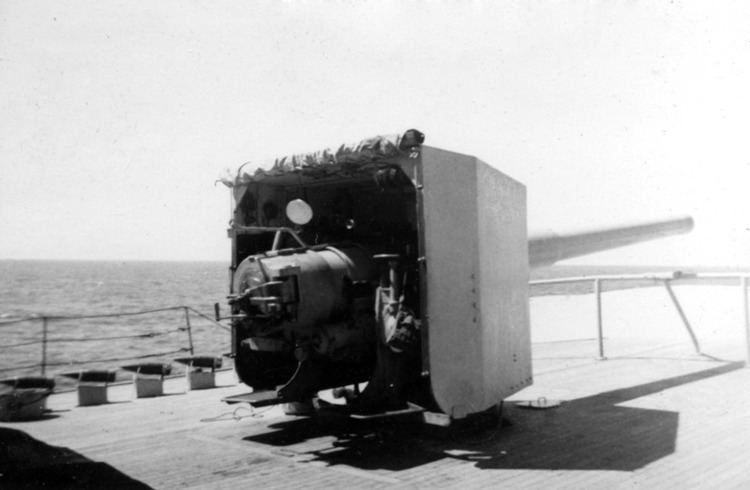Number built 898 | Designed 1899 | |
 | ||
Type Naval gunCoastal defence gunHeavy field gun Wars World War IWorld War II | ||
The BL 6 inch gun Mark VII (and the related Mk VIII) was a British naval gun dating from 1899, which was mounted on a heavy traveling carriage in 1915 for British Army service to become one of the main heavy field guns in the First World War, and also served as one of the main coast defence guns throughout the British Empire until the 1950s.
Contents
Background
The gun superseded the QF six-inch gun of the 1890s, a period during which the Royal Navy had evaluated QF technology (i.e. loading propellant charges in brass cartridge cases) for all classes of guns up to six inches to increase rates of fire. BL Mk VII returned to loading charges in silk bags after it was determined that with new single-action breech mechanisms a six-inch BL gun could be loaded, a vent tube inserted and fired as quickly as a QF six inch gun. Cordite charges in silk bags stored for a BL gun were also considered to represent a considerable saving in weight and magazine space compared to the bulky brass QF cartridge cases.
Naval gun
The gun was introduced on the Formidable-class battleships of 1898 (commissioned September 1901) and went on to equip many capital ships, cruisers, monitors, and smaller ships such as the Insect-class gunboat which served throughout World War II.
The Mk VIII in naval service was identical to the Mk VII, except that the breech opened to the left instead of to the right, for use as the left gun in twin turrets.
Guns were mounted in the following ships :
In World War II the gun was used to arm British troop ships and armed merchant cruisers, including HMS Rawalpindi, which briefly fought the German 11-inch gun battlecruisers Scharnhorst and Gneisenau in November 1939, and HMS Jervis Bay which similarly sacrificed herself to save her convoy from the 11-inch pocket battleship Admiral Scheer in November 1940 .
World War I field gun
The Mk VII gun was first used as a field gun in France in 1915. It was initially mounted on an improvised rectangular-frame field carriage designed by Admiral Percy Scott. The carriage was based on a design he had improvised for the 4.7-inch gun in the Second Boer War. It was a successful carriage, except that it limited the elevation and hence the range. A better carriage which allowed elevation to 22°, the MK II, was introduced early in 1916. This was followed by Mk III, V and VI carriages. The gun was operated by the Royal Garrison Artillery in batteries of four, as were all the larger field guns in World War I.
Following successful deployment in the Battle of the Somme, the role of the gun was defined as counter-battery fire. They "were most effective for neutralising defences and for wire cutting with fuze 106 (a new fuze which reliably burst instantly above ground on even slight contact, instead of forming craters)". They were also effective for long-range fire against "targets in depth". The Mk VII was superseded by the lighter and longer-range BL 6-inch Gun Mk XIX which was introduced from October 1916, but the Mk VII remained in service to the end of World War I.
Coast defence gun
The 6-inch Mk VII gun, together with the 9.2-inch Mk X gun, provided the main coast defence throughout the British Empire, from the early 1900s until the abolition of coast artillery in the 1950s. Many guns were specially built for army coast defence use, and following the decommissioning of many obsolete cruisers and battleships after World War I, their 6-inch Mk VII guns were also recycled for coast defence. During World War I, 103 of these guns were in service in coastal defences around the UK. Some of these, together with others at ports around the wider British Empire, played an important defence role in World War II and remained in service until the 1950s.
A number of new similar guns with stronger barrels which allowed more powerful cordite charges to be used were manufactured for coast defence during World War II, and were designated 6-inch BL Mark XXIV.
Notable actions
In the German raid on Scarborough, Hartlepool and Whitby on 16 December 1914, a notable action was fought by Durham Company RGA of the Territorial Force at Heugh (2 guns) and Lighthouse (1 gun) batteries defending Hartlepool. They duelled with the German battlecruisers Seydlitz and Moltke (11 inch guns) and Blücher (8.2 inch), firing 112 rounds and scoring 7 hits. The battlecruisers fired a total of 1,150 rounds at the town and the batteries causing 112 civilians and 7 military killed.
